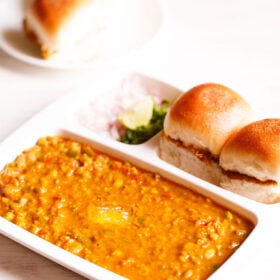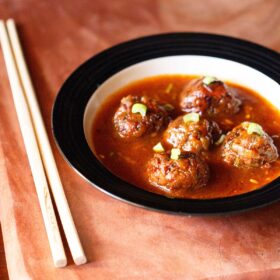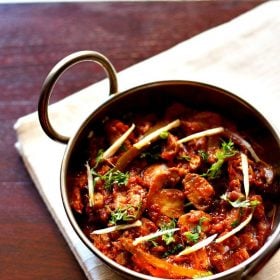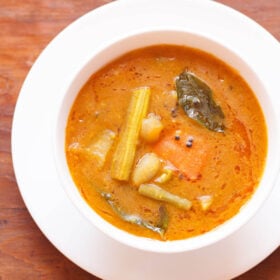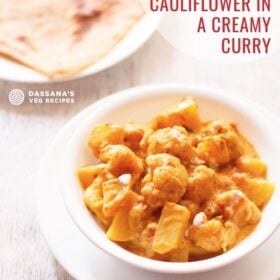Aloo gobi is a zesty and comforting Indian side or main dish made with fresh cauliflower and tender potatoes. Here I share with you step-by-step instructions and photos for two different but equally delicious aloo gobi recipes: A rich and creamy restaurant style version, and a slightly lighter dry sabji variation.
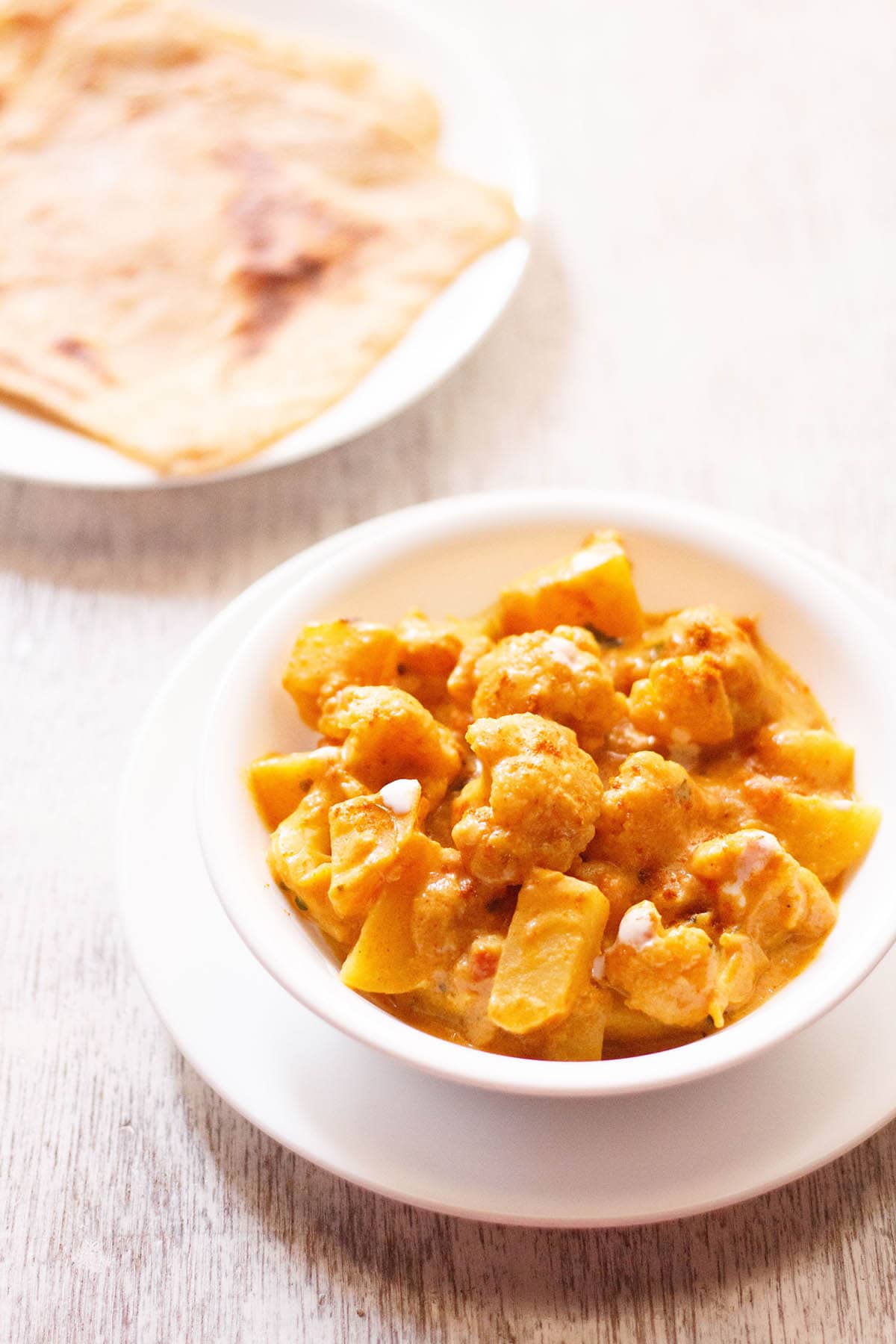
Table of Contents
About These Aloo Gobi Recipes
Aloo Gobi is a rustic and satisfying dish that can be enjoyed as either a side or main entree. “Aloo” is the Hindi word for potatoes, and “gobi” means cauliflower. These two simple veggies are cooked with bold spices for a vegetarian – even vegan – recipe that is wholesome and simple but exciting to enjoy.
There are two popular preparation methods to make aloo gobi at my home. Both are incredibly tasty, but wonderfully unique. I suggest you give them each a try on different occasions and see which your family prefers!
Below you’ll find step-by-step photos and details for making two delicious variations:
- Aloo Gobi Curry – A restaurant style dish that features a rich and creamy tomato gravy.
- Aloo Gobi Sabzi – A Punjabi style dry version that’s sautéed with only a handful of simple ingredients.
Restaurant Style Aloo Gobi Masala
This restaurant style Aloo Gobi masala recipe makes a dish that is wonderfully luscious and rich, and is personally my favorite version. It includes a thick, vegetarian gravy made mostly with tomatoes and cashews.
If the sauce of the restaurant style aloo gobi seems familiar, it’s likely because this recipe uses the same makhani gravy that is added to make Paneer Butter Masala or Paneer Makhani. The only difference being there are onions in this aloo gobi curry, and it is slightly more spiced than a traditional makhani gravy.
While I’ve included butter and cream to make the creamiest and most indulgent sauce, feel free to omit these ingredients for a completely vegan restaurant style aloo gobi. The cashews and tomatoes will still create a wonderfully rich sauce on their own!
Want more creaminess? You can also add your choice of paneer or vegan-friendly tofu towards the end of cooking the aloo gobi.
I recommend you serve creamy, saucy, curry style aloo gobi masala with a side of steamed rice and fresh roti, paratha, or naan. Together they make for a terrifically hearty meal that’s perfect to serve at nearly any gathering, large or small!
Recipe 1 – Aloo Gobi Curry
1. First, soak the cashews in hot water for a total of 20 to 30 minutes. You can start this process just before you begin to make the rest of the recipe.
Next, rinse a medium-sized cauliflower in fresh water for a couple of times. Chop the cauliflower into medium-sized florets.
Blanch fresh cauliflower florets in hot water. Using the microwave or stovetop, bring plenty of water and a generous pinch of salt to a full boil.
Add the florets to a heat-safe bowl, and cover with the boiling water. Let soak for 15 to 20 minutes while you make the aloo gobi sauce.
After 15 to 20 minutes of blanching, drain the water and optionally rinse the cauliflower florets. Set them aside.
Note that this blanching step is optional and skip it if you use homegrown cauliflower or if it does not have any insects or worms.
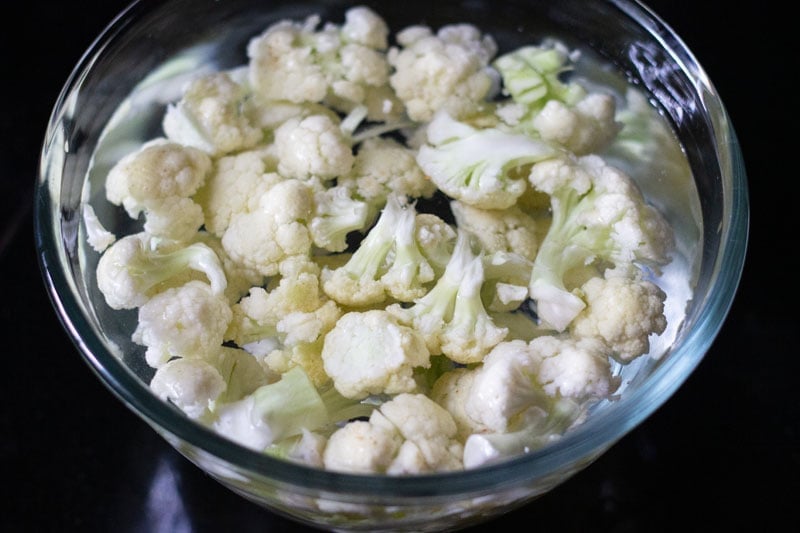
2. After they’ve soaked for the full 20 to 30 minutes, drain the water. Add the cashews to a spice grinder or blender and blend to create a smooth, thick paste with 2 tablespoons of water
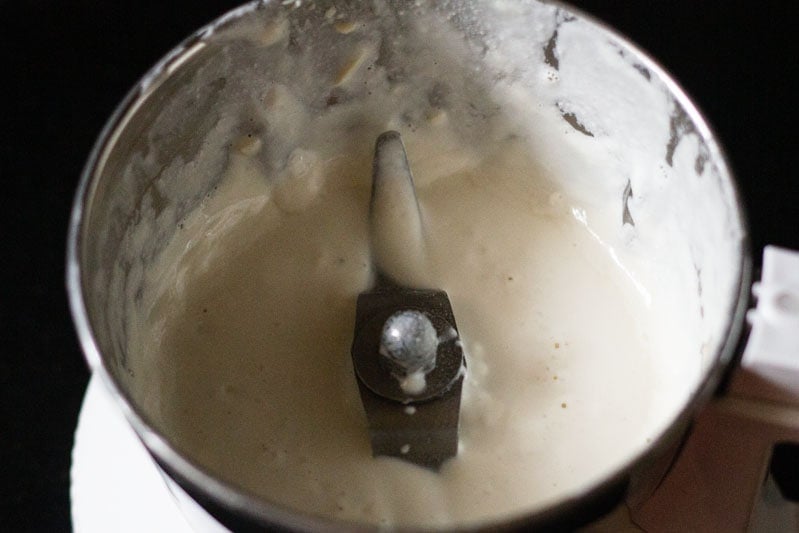
3. Meanwhile, in large pan over medium heat add 1 tablespoon of butter (or ghee) plus 2 tablespoons of your preferred cooking oil. Once hot add the whole spices:
- 1 inch of cinnamon
- 1 bay leaf
- 2 to 3 green cardamoms
- 2 to 3 cloves
- 1 black cardamom
- 1 single strand of mace
Fry the spices in the hot butter and oil for a few seconds or so, until they become fragrant.
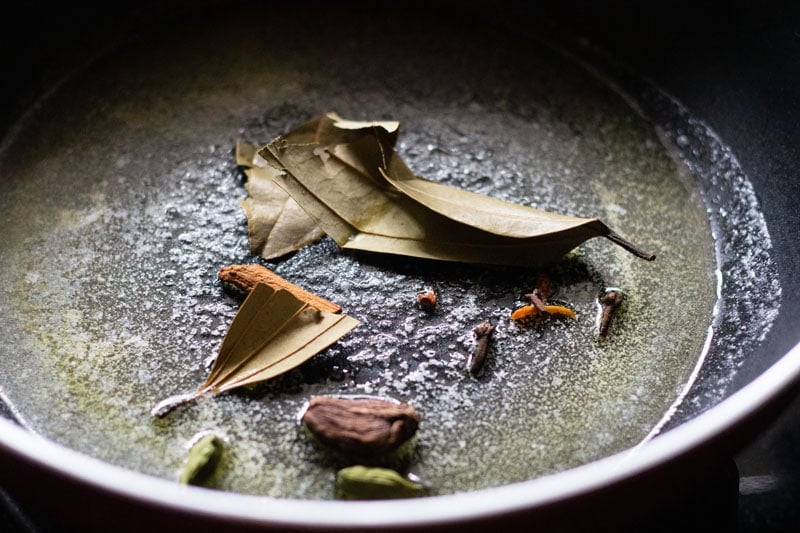
4. Add ½ cup chopped onions.
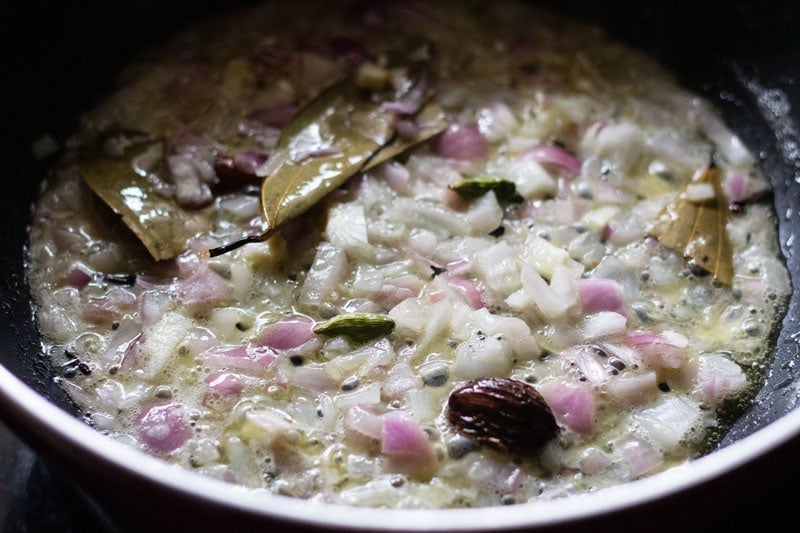
5. Continue to stir and sauté the onions and spices. The onions should become golden. Stir the onions often while sautéing so that they cook evenly.
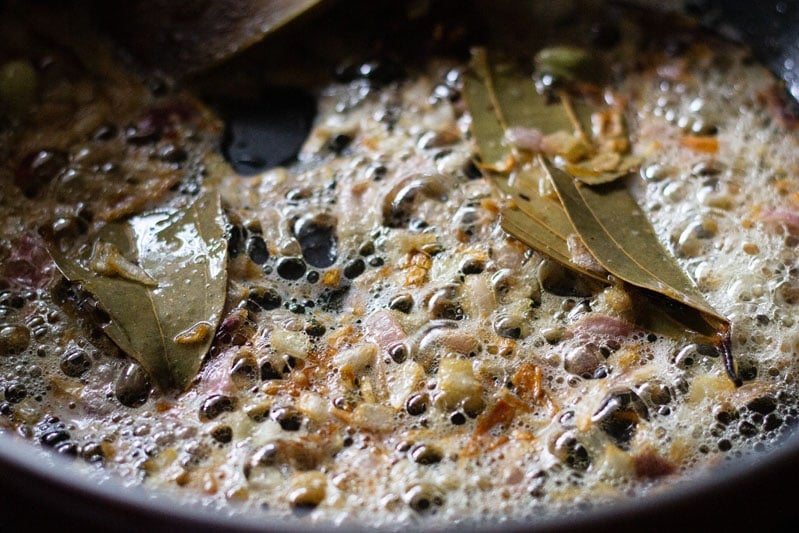
6. Add about 1 teaspoon (more or less to taste) of ginger-garlic paste, and saute for a few seconds or until no longer raw smelling. Lower the heat a bit if needed to keep the paste from burning.
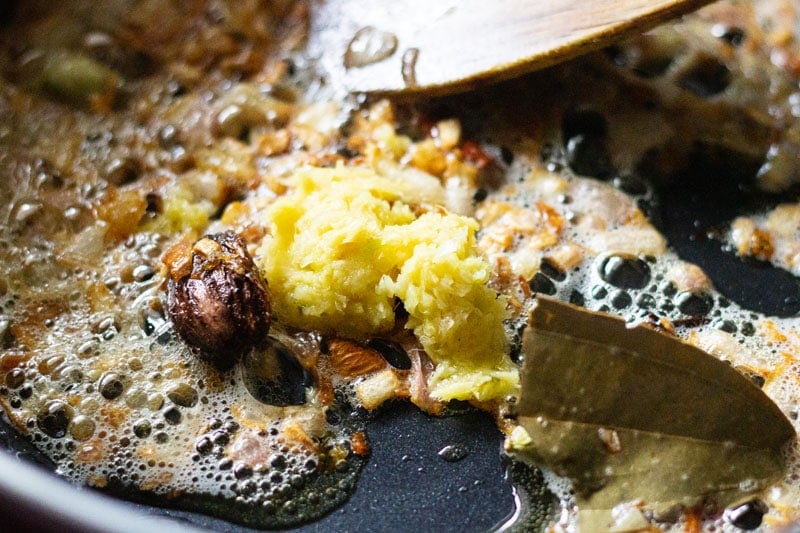
7. Now add 2 large sized finely chopped tomatoes (approx 2 to 2.5 cups finely chopped tomatoes).
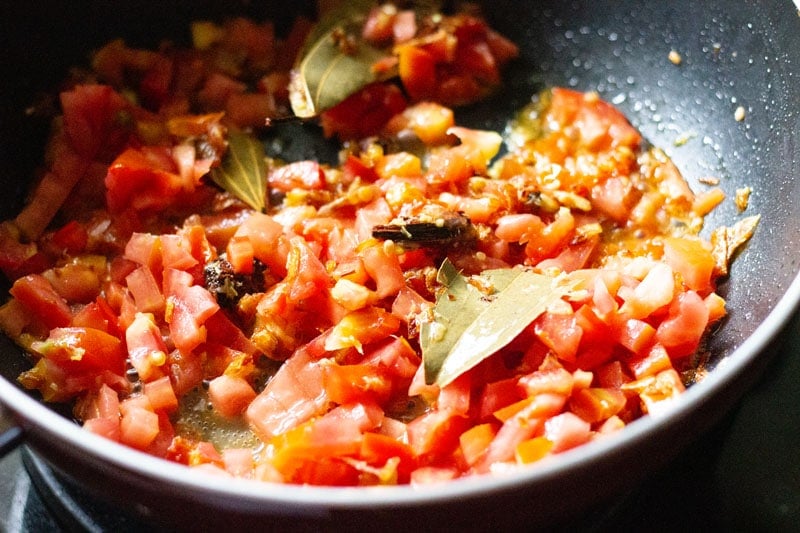
8. Stir well and saute until the tomatoes soften and become pulpy. This takes about 5 to 7 minutes on low to medium heat.
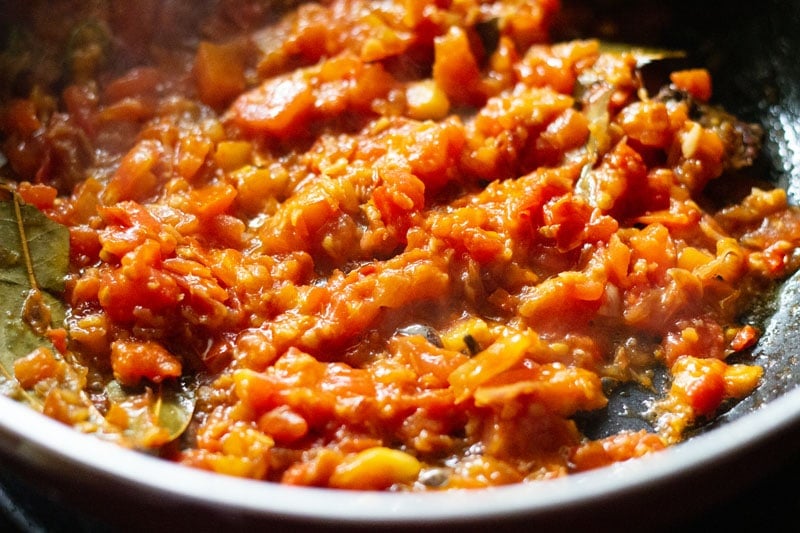
9. Then add the cashew paste along with following ground spices:
- ½ teaspoon of Kashmiri red chili powder (or deghi mirch, or ¼ teaspoon of red chili powder or cayenne pepper)
- ¼ teaspoon of turmeric powder
- 1 teaspoon of coriander powder
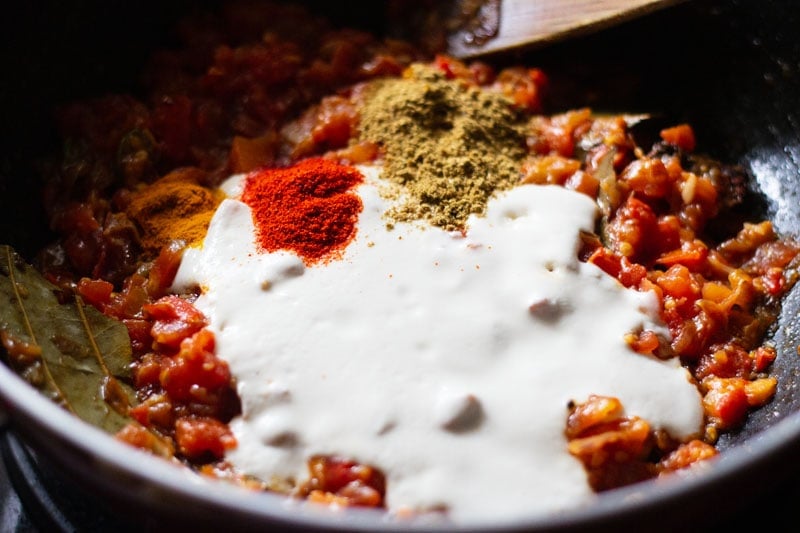
10. Stir and mix well to create a thick paste like mixture.
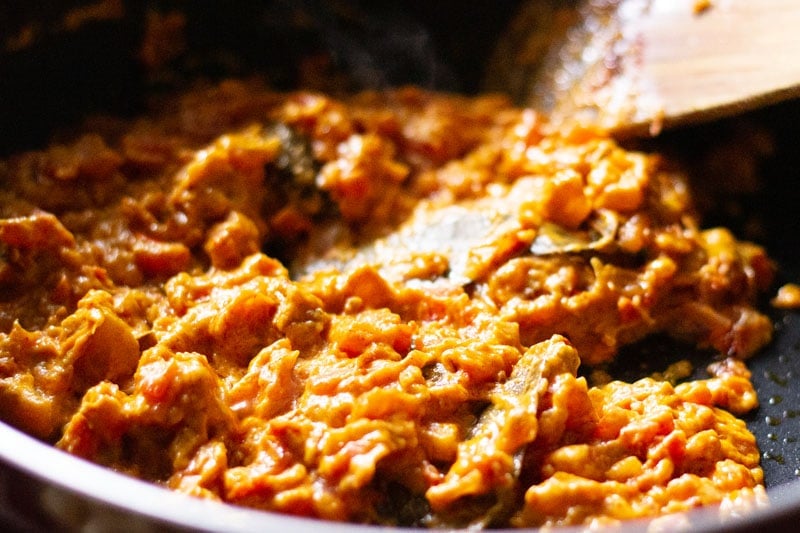
11. Keep sauteeing and stirring regularly until the fat starts to separate from the masala mixture. This should take about 8 to 10 minutes after the cashew cream is added. The masala paste mixture will leave the sides of the pan, thicken and look glossy.
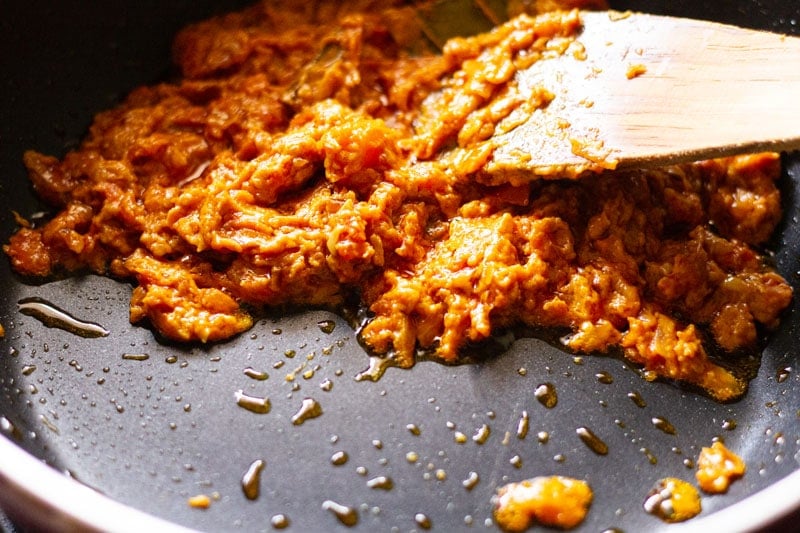
12. Rinse and add the blanched cauliflower florets, plus 2 medium sized potatoes that have been peeled and chopped (approx 2 to 2.5 cups of diced potatoes).
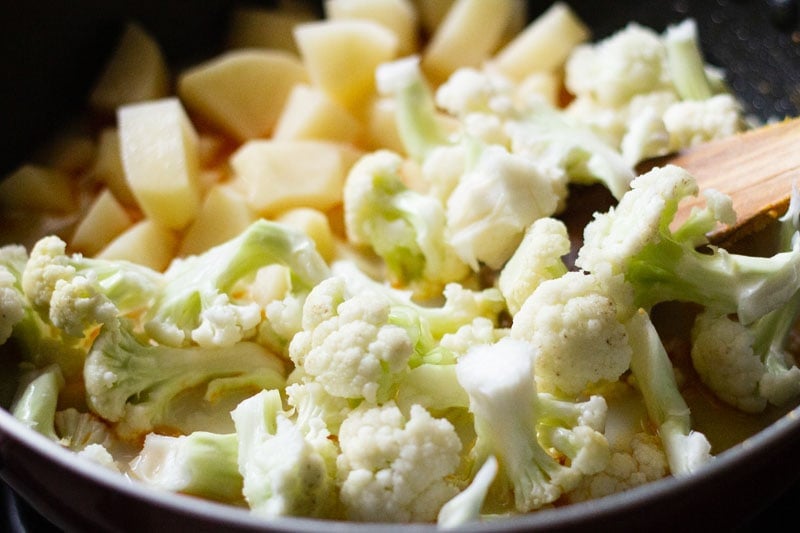
13. Stir, and then pour in 1.5 to 2 cups of water. Taste and season with salt as needed.
For a thicker consistency in the gravy you can add less water. I get cauliflower which takes more time to cook, so I add about 2 cups of water. If you have cauliflower that cooks faster then add less water.
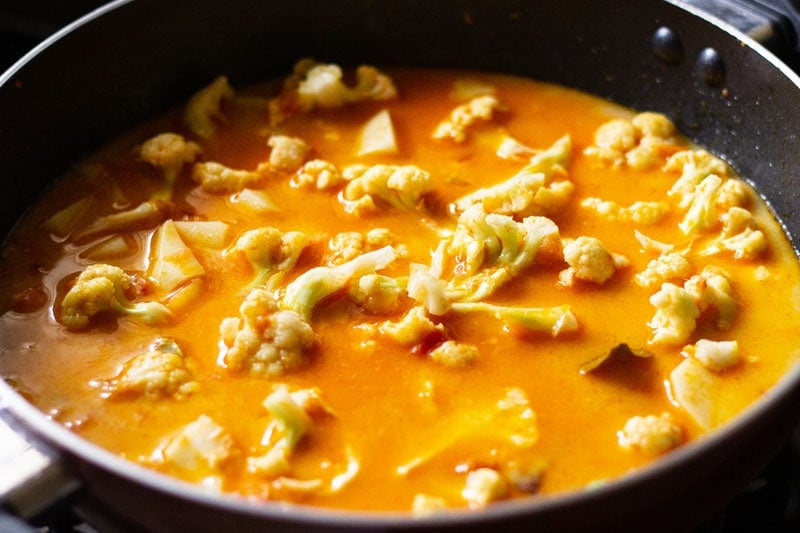
14. Reduce the heat to low, and cover the pan with a lid. Simmer until the potatoes and cauliflower are both just fork-tender. Check and stir regularly, and add a bit of water (up to 2 to 3 tablespoons or more, if the water dries) as needed.
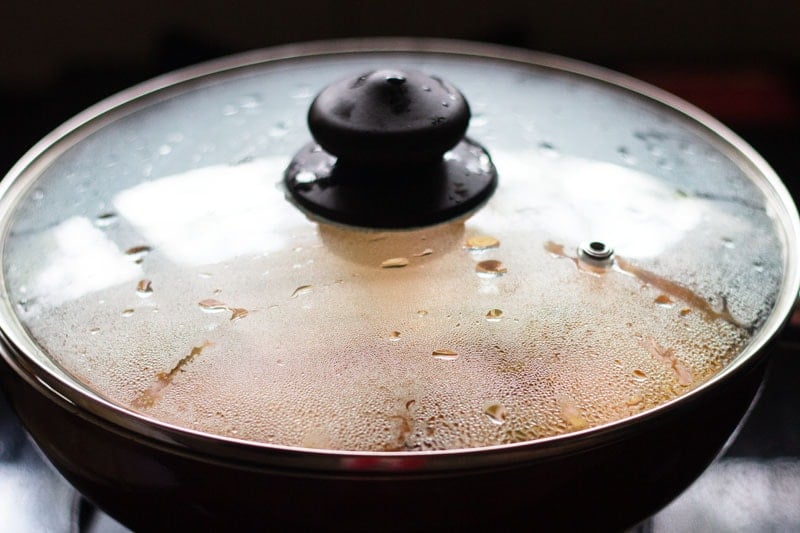
15. The aloo gobi gravy should be creamy and thick by the time the cauliflower and potatoes are cooked.
Once they are done, add the following ingredients:
- ½ a teaspoon of crushed kasuri methi (dry fenugreek leaves)
- ¼ to ½ teaspoon of garam masala powder
- 2 tablespoons of heavy cream (for a non-vegan version) or 3 tablespoons of light cream or cooking cream (low fat cream).
Stir and simmer uncovered for less than a minute, and remove from the heat right away.
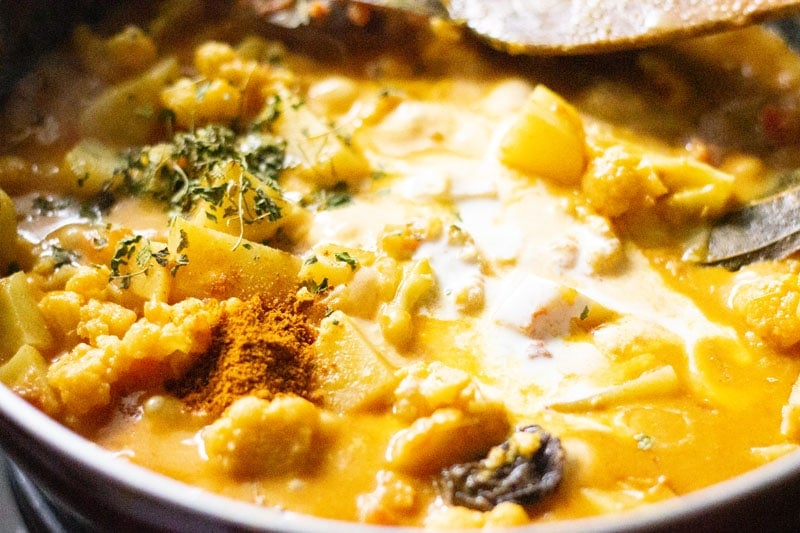
16. Serve aloo gobi masala with steamed basmati rice, cumin rice, or Saffron Rice, and your choice of Roti, Paratha or Naan on the side. You can opt to garnish with some coriander leaves (cilantro) or mint while serving.
Leftovers will keep well in a sealed container in the refrigerator for about 1 day.
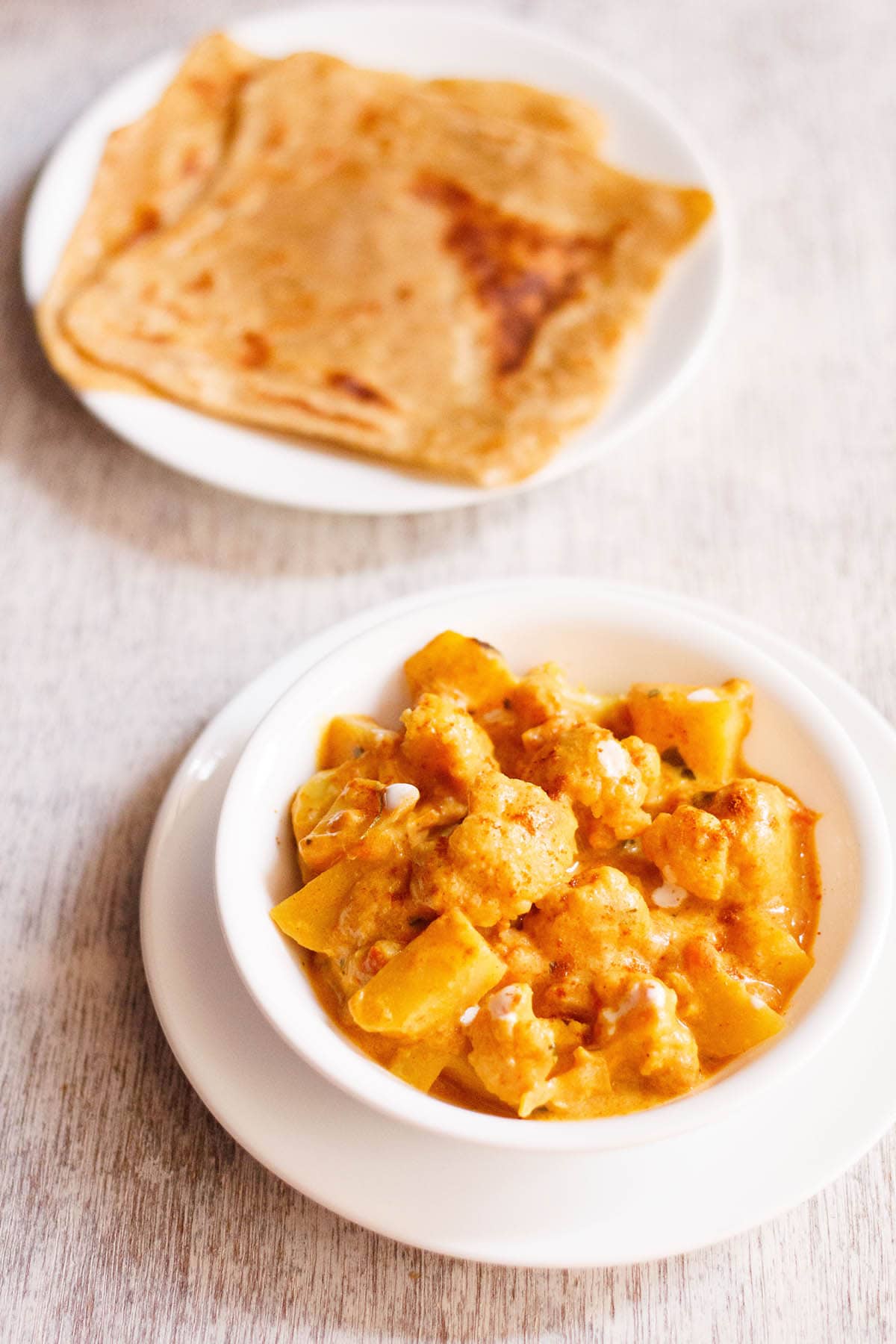
Dry Aloo Gobi Sabji
This recipe variation has a video as well as step by step photos. An easy, simple, homely and tasty aloo gobi dry made with 6 ingredients.
This simple Punjabi recipe of dry aloo gobi is a regular at home and also the family favorite.
I have had many different varieties of aloo gobi. This recipe is the way we make it at home and a family recipe. It is my mom-in-law’s special recipe. Most of her recipes are easy and quick to make and yet taste delicious.
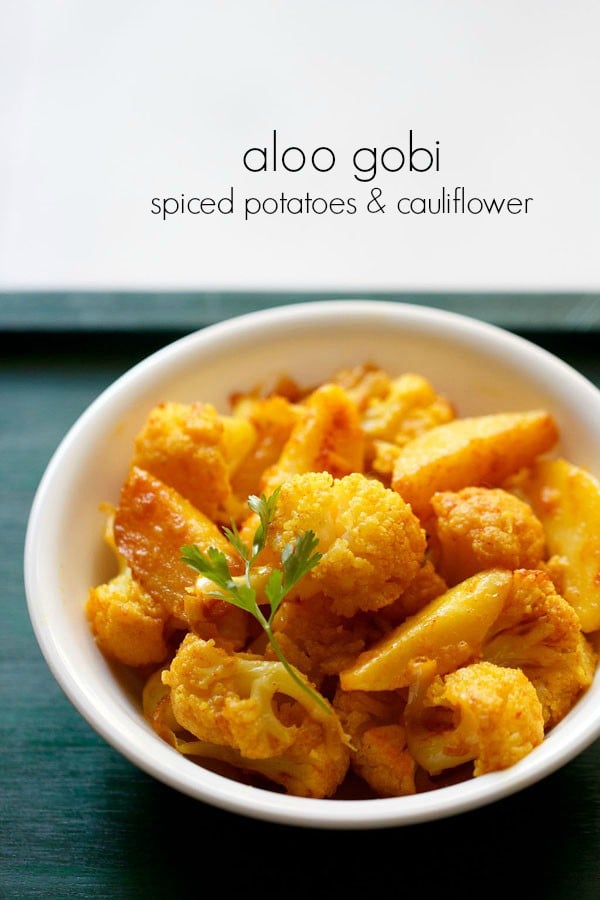
Initially, when I used to cook this dish, I just couldn’t get the gobi to get cooked. As a result, I would add some water and steam and thus the dish would become soggy and mushy.
After many trials and errors, I have mastered the art of cooking this aloo gobi dish. It just requires patience and slow cooking. Plus the cauliflower and potatoes have to be sautéed for some time before they are steamed.
Apart from cauliflower and potatoes, ginger, red chili powder and garam masala is also added. So this Aloo gobi sabzi derives it main flavor and aroma from ginger, red chili powder and garam masala.
The dish has the gingery taste in it. So if you like ginger then you will like this easy and simple variation.
This is dry sabzi and goes very well with roti, paratha, bread or naan. It can also be had as a side vegetable dish with the main course of dal-rice. It can also be packed for lunch box with a side of roti or paratha or bread.
Recipe 2 – Dry Aloo Gobi Sabji
1. Rinse 1 medium sized cauliflower a couple of times in water. Chop into medium florets. Boil water to which some salt has been added and take it in a bowl or pan. Add the cauliflower florets.
Cover the bowl and blanch them in the hot water. I usually get cauliflower, which takes a lot of time to cook. So I blanch the florets for 15 to 20 minutes. But you can blanch for a few minutes to 5 minutes.
Meanwhile, peel and slice 5 to 6 medium-sized potatoes in wedges. After 15 to 20 minutes, drain the cauliflower. Rinse with fresh water if preferred and set aside. The step of blanching is optional and is only done if there are insects in the cauliflower.
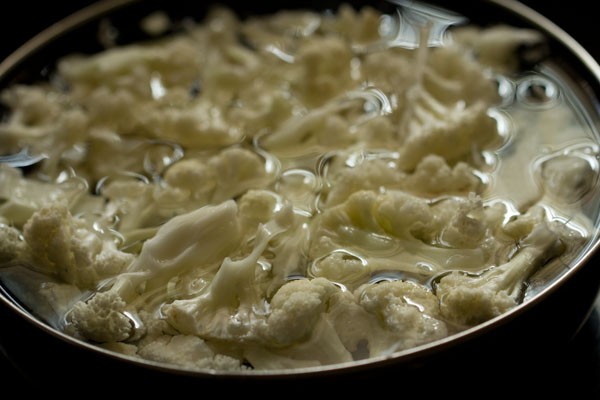
2. In a kadai or thick bottomed pan, heat oil or ghee (clarified butter).
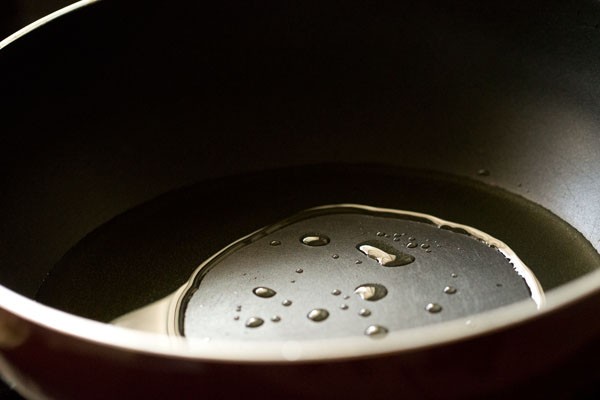
3. Lower the flame and add the potato wedges.
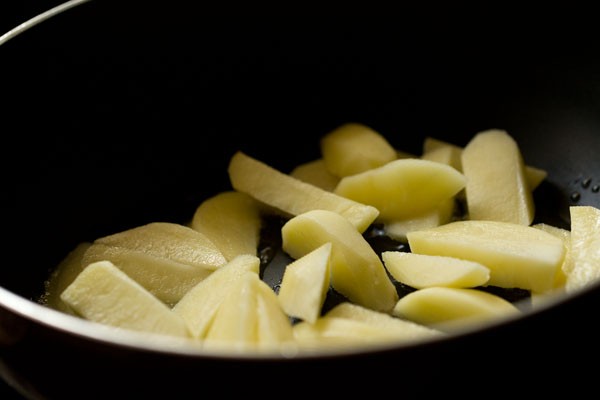
4. Stir the potatoes well and saute them on a low flame or sim for 6 to 7 minutes. Stir a couple of times when sauteing them for even cooking.
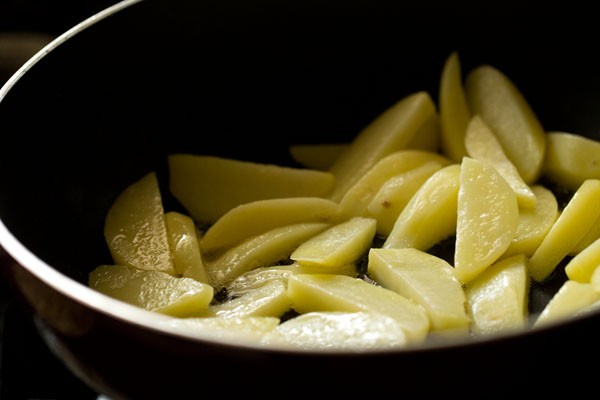
5. Add the cauliflower and sauté for about 3 to 4 minutes. Continue to stir in between.
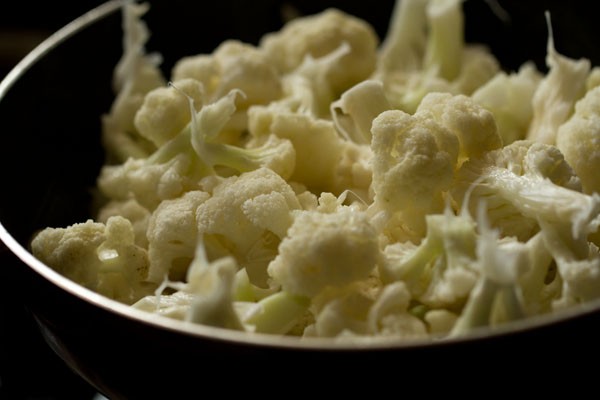
6. Add 4 teaspoons of chopped ginger. Stir again very well.
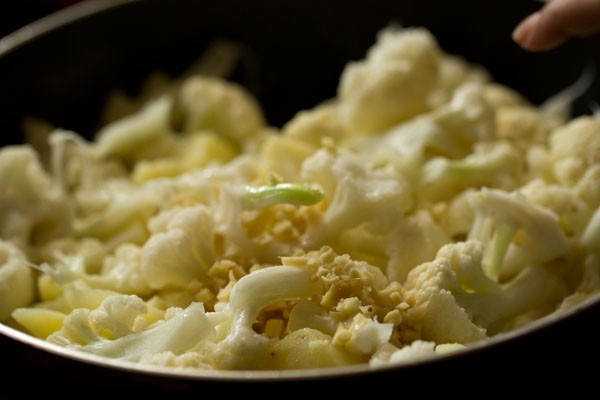
7. Then add ½ teaspoon turmeric powder, 1 teaspoon Kashmiri red chili powder and salt as required.
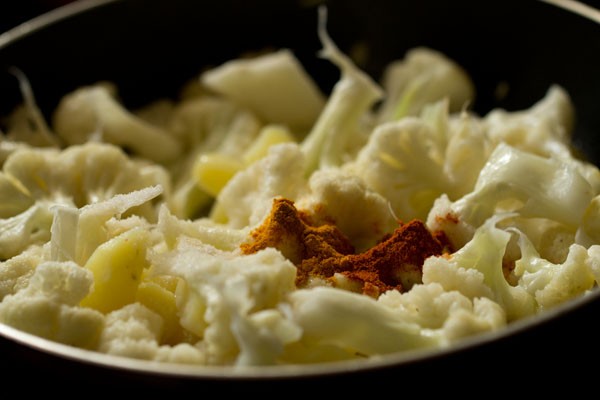
8. Combine and mix very well so that the spices are mixed uniformly in the sabzi and coat the veggies evenly.
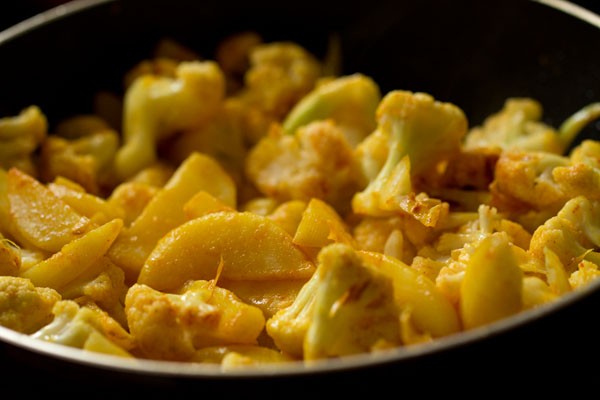
9. Cover the pan with its lid tightly.
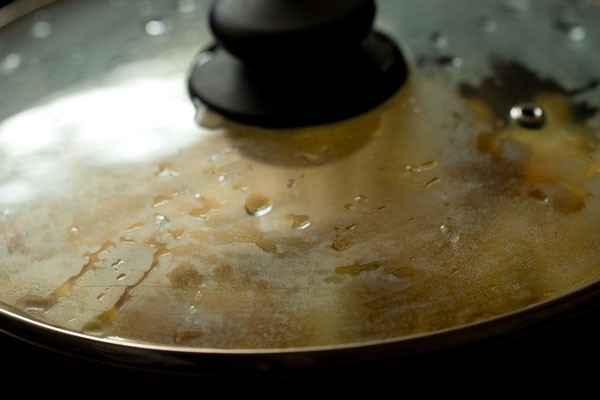
10. Simmer for 18 to 20 minutes on a low flame. Timing will vary with the size, depth and quality of the pan and flame intensity.
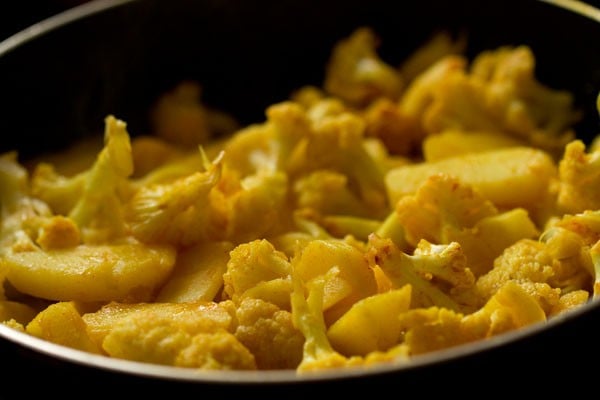
11. In between for a couple of times, remove the lid and stir well.
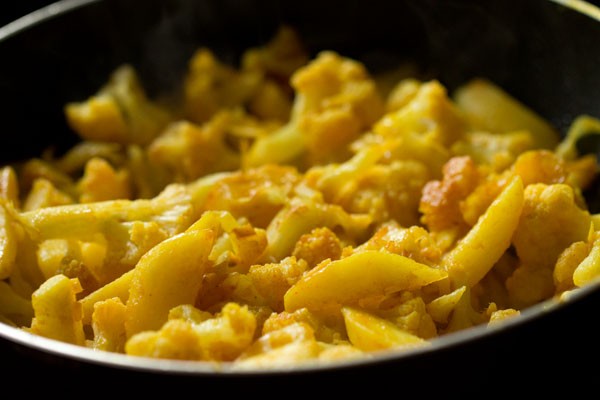
12. Cover and then again continue to cook. Do not add any water. The veggies will be cooked with the steam inside the pan. But in case the veggies starts sticking to pan then add a few splashes of water. Mix and deglaze. Cover with lid and continue to cook.
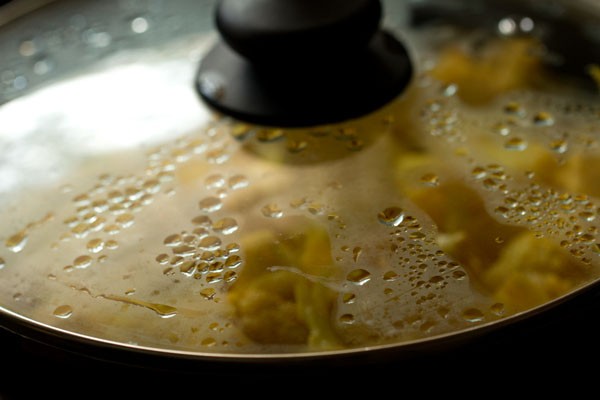
13. Once the potatoes and cauliflower have cooked, softened and have become fork tender, sprinkle ½ teaspoon garam masala powder and mix it with the entire sabzi.
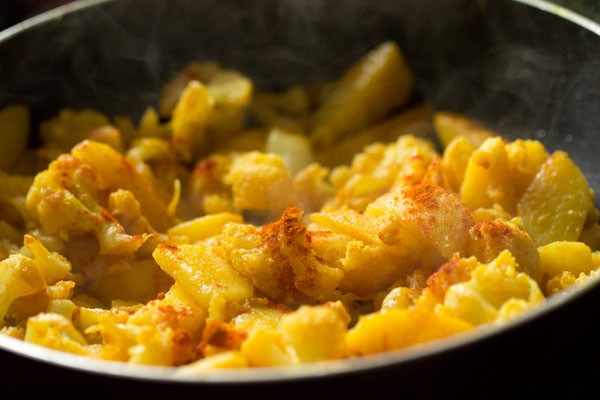
14. Serve this dry aloo gobi sabzi with roti or paratha or bread and a bowl of curd (yogurt). The recipe also makes for a tiffin box brunch or lunch with a side of roti or bread. If you want you can garnish with a few coriander leaves.
You can also serve this dish with any Indian main course.
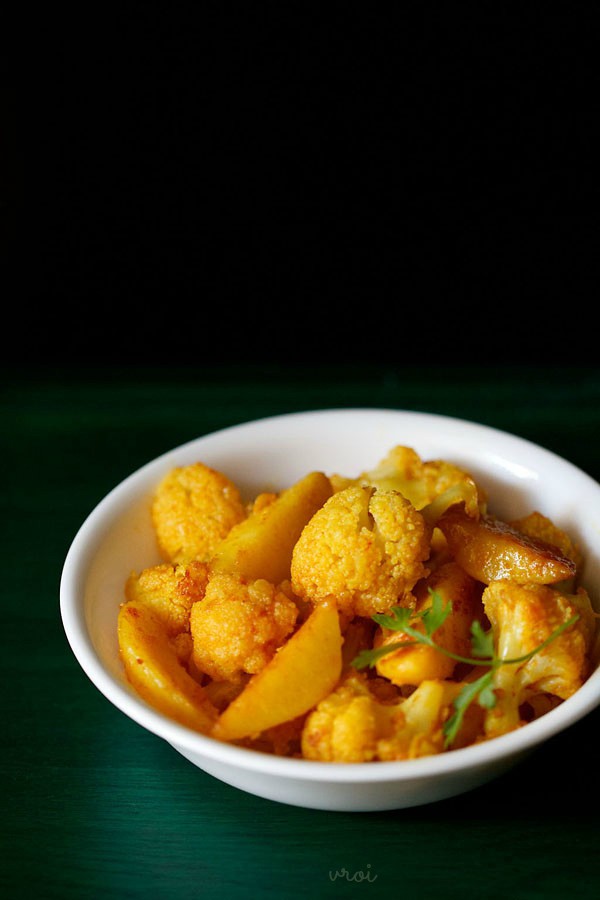
Expert Tips for Aloo Gobi
- Cauliflower: Use fresh and tender cauliflower. Sometimes your cauliflower may have worms or insects. To get rid of these, blanch the chopped cauliflower in hot boiling water for 15 minutes as I have explained in the stepwise photos above.
- Potatoes: To make aloo gobi, you can easily use red skinned potatoes, baby potatoes, russet potatoes and yukon gold (yellow potatoes).
- Spicing: Feel free to adjust the spices according to your preferences. Both the recipes are not spicy, so you can add some more green chillies or red chili powder for a spicy taste.
- Fat: Most often I make both these aloo gobi recipes in oil, though you can opt to use ghee or butter.
- Cooking times: Try to cut the potatoes and cauliflower in the same size, so that they get cooked evenly. The cooking time will vary with the kind of potatoes and cauliflower you use.
- Variations: For a hearty meal, add veggies like carrots, green peas, french beans or sweet corn in the aloo gobi curry.
More Tasty Dinner Recipes for You to Try:
- Gobi Masala – creamy, delicious and lightly spiced gobi masala made restaurant style.
- Cauliflower Curry – healthy and delicious cauliflower gravy dish.
- Jeera aloo – an easy and quick recipe of potatoes spiced with cumin seeds.
- Potato fry – simple, easy and tasty recipe of potato fry.
- Cauliflower fry – easy and quick cauliflower recipe inspired from the Kerala cuisine.
Please be sure to rate the recipe in the recipe card or leave a comment below if you have made it. For more vegetarian inspirations, Sign Up for my emails or follow me on Instagram, Youtube, Facebook, Pinterest or Twitter.
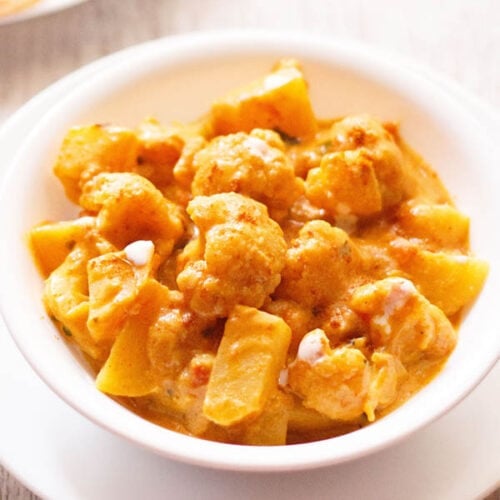
Aloo Gobi (2 Ways)
Ingredients
Recipe 1 – Aloo Gobi Curry (Restaurant Style)
For Cashew Paste
- 15 whole cashews
- ½ cup hot water – for soaking cashews
- 2 tablespoons water – for blending cashews
Main Ingredients
- 2 tablespoons oil – any neutral oil
- 1 tablespoons Butter
- ½ cup chopped onions or 1 medium-sized onion
- 1 to 1.25 teaspoons Ginger Garlic Paste or 1 inch ginger and 3 to 4 medium garlic cloves crushed in a mortar-pestle
- 2 to 2.5 cups finely chopped tomatoes or 2 large tomatoes
- ¼ teaspoon turmeric powder
- ½ teaspoon kashmiri red chili powder or deghi mirch or ¼ teaspoon red chili powder or cayenne
- 1 teaspoon Coriander Powder
- 2.5 to 3 cups chopped cauliflower florets or 1 medium-sized cauliflower
- 2 to 2.5 cups diced potatoes or 2 medium-sized potatoes
- 2 tablespoons cream – whipping cream or heavy cream or 3 tablespoons light cream or cooking cream
- ½ teaspoon dried fenugreek leaves (kasuri methi), crushed
- ¼ to ½ teaspoon Garam Masala or tandoori masala powder
- 1.5 to 2 cups water or as needed
- salt as required
Whole spices
- 1 inch cinnamon
- 1 tej patta (Indian bay leaf)
- 2 to 3 green cardamoms
- 2 to 3 cloves
- 1 black cardamom
- 1 single strand of mace
Recipe 2 – Dry Sautéed Aloo Gobi Sabji
- 4 tablespoons oil or ghee (clarified butter)
- 400 to 450 grams cauliflower or 1 medium sized cauliflower, florets removed and rinsed
- 300 to 350 grams potatoes or 5 to 6 medium size potatoes, sliced in wedges
- 1.5 to 2 inches ginger or 4 teaspoons chopped ginger
- ½ teaspoon turmeric powder
- 1 teaspoon kashmiri red chili powder (or deghi mirch)
- salt as required
- ½ teaspoon Garam Masala
- 1 to 2 tablespoons chopped coriander leaves for garnish – optional
Instructions
Preparation – Recipe 1 for Aloo Gobi Curry (Restaurant Style)
- First soak the cashews in warm water for 30 minutes. Then drain and blend them to a smooth paste with about 2 tbsp water in a grinder or blender.
- Rinse and peel the potatoes and then dice them. Chop the onions and tomatoes finely.
- Rinse and chop the gobi/cauliflower into medium sized florets.
- Heat enough water with salt for the florets to be immersed in, on stove top or in the microwave.
- Add the rinsed florets and keep them immersed in the hot water for 15 to 20 mins. This is to to get rid of the insects or worms that might be in the cauliflower.
- Then drain the cauliflower and rinse once again with fresh water.
- Note that the blanching of cauliflower is an optional step. Skip this step if you use a homegrown cauliflower or if the cauliflower does not have any insects or worms.
Making aloo gobi curry
- Heat the butter and oil in a pan and add all the whole spices or whole garam masala listed above. Saute till the spices become fragrant.
- Then add the chopped onions and saute till they become golden.
- Add the ginger-garlic paste. Stir and saute till the raw aroma of the garlic-ginger goes away.
- Add the chopped tomatoes and sauté till the tomatoes become soft and pulpy. This takes about 5 to 7 minutes on a low to medium flame.
- Add the cashew paste and all the spice powders one by one – turmeric powder, red chilli powder and coriander powder.
- Stir and saute till you see fat coming from the sides of the masala paste.
- The masala paste will start getting together and you will clearly see the fat leaving the sides. This process takes about 8 to 10 minutes on a low to medium flame.
- Keep stirring often so that the masala does not stick to the pan.
- Add the cauliflower and the potatoes. Stir well. Then pour water and season with salt as required.
- Do add water as required. Where we live, I get cauliflower which takes more time to cook. Thus I add more water. If the cauliflower takes less time to cook, then add less water.
- Cover and cook the curry till the veggies are done but not falling apart. Stir for a few times when the veggies are simmering.
- If the gravy (sauce) thickens too much then just add a few tablespoons of water and simmer for a couple of minutes.
- Lastly add the garam masala powder, crushed kasuri methi and cream.
- Stir and simmer the curry for half a minute without the lid. You can garnish with chopped coriander leaves or mint leaves if you prefer.
- Serve the aloo gobi hot dotted with cream or butter and sprinkled with a pinch of garam masala, accompanied with rotis, naan or steamed basmati or cumin rice.
Preparation – Recipe 2 for Dry Aloo Gobi Sabji
- First rinse 1 medium sized cauliflower in fresh water for a couple of times. Chop into medium-sized florets.
- Boil water to which some salt has been added and take it a bowl or pan. Add the cauliflower florets.
- Cover the bowl and blanch them in the hot water. I usually get cauliflower, which takes lot of time to cook. So I blanch the florets for 15 to 20 minutes. But you can blanch for a few minutes to 5 minutes.
- After the blanching is over, drain all the water and rinse the florets once more if you prefer.
- The step of blanching is optional and is only done if there are insects or worms in the cauliflower.
- Meanwhile slice the potatoes in wedges.
Sautéing Potatoes
- In a kadai or thick bottomed pan, heat oil or ghee. Lower the flame and add the aloo/potato wedges.
- Stir the potatoes well and sauté them on a low flame or sim for 6 to 7 minutes. Stir a couple of times when sautéing them.
Sauté cauliflower
- Now drain the cauliflower of all the water and add them. Sauté cauliflower for 3 to 4 minutes. Continue to stir often.
- Add chopped ginger. Stir again very well. Spice up with turmeric powder, red chili powder and salt.
- Stir again very well, so that the spices are mixed uniformly in the sabzi and coat the veggies also evenly.
Cover and cook
- Cover the pan with its lid tightly. Cook the aloo gobi 18 to 20 minutes on a low heat. Timing will vary with the size, depth and quality of the pan and flame intensity.
- In between for a couple of times, remove the lid and stir well. Cover and then again continue to cook. Do not add any water. The steam inside the pan will help in the cooking of the veggies.
- But in case if the vegetables starts sticking on to the pan then sprinkle some water. Mix and deglaze removing the stuck ingredients from the pan. Then cover with lid and continue to cook.
- Once the potatoes and cauliflower have cooked, softened and fork tender, sprinkle garam masala powder and mix it with the entire sabzi.
- Serve aloo gobi ki sabji with rotis or parathas and a bowl of curd or bread. The recipe also makes for a tiffin box brunch or lunch. If you want you can garnish aloo gobi sabzi with a few coriander leaves.
Video
Notes
Nutrition Info (Approximate Values)
This recipe post is from the archives and has been updated and republished on August 2021.
